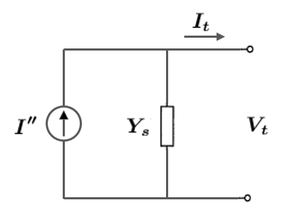Network Interfacing
In dynamic time-domain simulations, network interfacing refers to the interfacing of dynamic models to the network and involves two main tasks:
- Reference frame transformations
- Calculation of machine current injections
Reference Frame Transformations
Machine quantities such as voltage and current are typically expressed in dq coordinates with a synchronous reference frame that is relative to the individual machine's rotor angle. On the other hand, it is convenient to express all network quantities in phasor coordinates (i.e. a common synchronously rotating real-imaginary reference frame). Therefore, a reference frame transformation is required to interface between network and machine quantities. The transformation is essentially a rotation of phasor or dq vector by the machine rotor angle.
Voltages and currents are transformed from the dq frame to the common phasor frame as follows (shown for voltages):
The inverse transformation is as follows:
Calculation of Machine Current Injections
Machines are interfaced to the network via a source impedance (R + jX) and to improve numerical stability, the source impedances are incorporated directly into the modified admittance (Ybus) matrix. Therefore, machine current injections must be calculated to take the source impedance into account. This is depicted in the Norton equivalent circuit:
where Vt is the voltage at the machine terminals, It is the current injected into the machine terminals, Ys is the source impedance interfacing the machine to the network and I" is the total machine current injection (sometimes called the 'pseudo-current').
The current injections into the machine terminals (It) are first calculated in the individual machine's dq reference frame (which are readily computed from the machine equations). The current injections are then transformed to the common network frame:
The total machine current injection (psuedo-current) is then calculated as follows:
![{\displaystyle \left[{\begin{matrix}V_{r}\\V_{i}\end{matrix}}\right]=\left[{\begin{matrix}\cos {\delta }&-\sin {\delta }\\\sin {\delta }&\cos {\delta }\end{matrix}}\right]\left[{\begin{matrix}V_{q}\\V_{d}\end{matrix}}\right]}](https://wikimedia.org/api/rest_v1/media/math/render/svg/8b03da621a81fde351f57cdfbc4d8d2d39579c13)
![{\displaystyle \left[{\begin{matrix}V_{q}\\V_{d}\end{matrix}}\right]=\left[{\begin{matrix}\cos {\delta }&\sin {\delta }\\-\sin {\delta }&\cos {\delta }\end{matrix}}\right]\left[{\begin{matrix}V_{r}\\V_{i}\end{matrix}}\right]}](https://wikimedia.org/api/rest_v1/media/math/render/svg/a70cf2612990f00183ebe71c429d3e12d4a8d531)

![{\displaystyle {\boldsymbol {I_{t}}}=\left[{\begin{matrix}I_{t,r}\\I_{t,i}\end{matrix}}\right]=\left[{\begin{matrix}\cos {\delta }&-\sin {\delta }\\\sin {\delta }&\cos {\delta }\end{matrix}}\right]\left[{\begin{matrix}I_{t,q}\\I_{t,d}\end{matrix}}\right]}](https://wikimedia.org/api/rest_v1/media/math/render/svg/1438bd11cddc338e4a897c1483df852f7bd80223)
